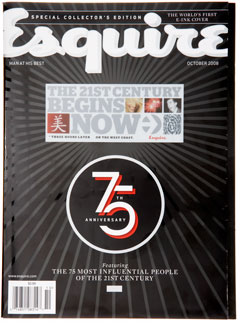I know I'm about a month behind on this topic, considering Esquire released the world's first e-ink cover in October 2008. But, as it's an ever-fascinating concept, I feel it's not too late to join in the discussion. As the age-old saying goes, better late than never. 
"The 21st Century Begins Now" reads the formidable Esquire cover, its bold, flashing text leaping from an edgy, black exterior. The phrase, rotating between soft gray font and stark white text, transfixes consumers as they pass by, both dazzled and confounded by the magazine's innovative visage. How do I know this, you may be wondering? Well it just so happens that I, too, fell victim to its glossy gaze.
I was at Borders purchasing yet another beloved Margaret Atwood novel when my eyes fell unassumingly upon Esquire's cover, a postmodern amalgamation of sleek aesthetics and electronic ink. Moving words and flashing images comprise the front cover, its images backlit with e-ink; while the inside display is coated with a moving car advertisement for Ford Flex Crossover, its motion powered by a flashing loop. A Special Collector's Edition, the experimental cover marked Esquire's 75th Anniversary Issue, of which only a limited supply - 100,000 - was released.
For those of you unfamiliar with electronic ink and electronic paper displays (EDP's), I'll gladly introduce you to the technology. According to leading e-ink developer E-Ink Corporation, EDP's are high resolution, low power displays, like Amazon's electronic book reader, the Kindle, or the Sony Reader. These EDP's, which display a "paper-like high contrast" use electronic ink, which carry a charge, thereby enabling it to be updated through electronics. This electronic ink is essentially the foundation for Esquire's digital cover.
According to Esquire, its e-ink cover took approximately a year to develop, and traveled about 7,000 miles prior to hitting local book stands. The issues' display screen, electronics, and batteries were assembled in Shanghai, China, using components from at least 7 different factories. Once activated, the devices were then shipped to Negras, Mexico, via Dallas, in refrigerated trucks, thereby preserving the battery life. Once in Mexico, 100,000 covers were then assembled by hand. From Mexico, the assembled covers found their home in Kentucky, where they were bound to the magazine itself. It's transnational labor at its finest.
Ultimately, the cover's small circuit board, which contains six button cell batteries, has a life span of about 90 days - a reasonably long life considering its $6 price tag. Greater longevity can be attained, however, when stored in the refrigerator or freezer.
For the most part, Esquire's e-ink magazine cover was met with mixed reviews, some lauding Esquire for its ingenious hybrid. Others, however, were thoroughly disappointed, considering the rather bulky issue to be a primitive rendering of the world's first e-ink cover. Either way, it's a striking innovation, and I'm sure Esquire is quite content to be the pioneer in the e-ink magazine industry.
To see Esquire's October cover in all it's flashing glory, check out YouTube's video.

